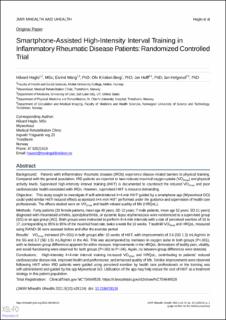| dc.description.abstract | Background: Patients with inflammatory rheumatic diseases (IRDs) experience disease-related barriers to physical training. Compared with the general population, IRD patients are reported to have reduced maximal oxygen uptake (VO2max) and physical activity levels. Supervised high-intensity interval training (HIIT) is documented to counteract the reduced VO2max and poor cardiovascular health associated with IRDs. However, supervised HIIT is resource demanding. Objective: This study sought to investigate if self-administered 4×4-min HIIT guided by a smartphone app (Myworkout GO) could yield similar HIIT-induced effects as standard 4×4-min HIIT performed under the guidance and supervision of health care professionals. The effects studied were on VO2max and health-related quality of life (HRQoL). Methods: Forty patients (33 female patients, mean age 48 years, SD 12 years; 7 male patients, mean age 52 years, SD 11 years) diagnosed with rheumatoid arthritis, spondyloarthritis, or systemic lupus erythematosus were randomized to a supervised group (SG) or an app group (AG). Both groups were instructed to perform 4×4-min intervals with a rate of perceived exertion of 16 to 17, corresponding to 85% to 95% of the maximal heart rate, twice a week for 10 weeks. Treadmill VO2max and HRQoL measured using RAND-36 were assessed before and after the exercise period. Results: VO2max increased (P<.001) in both groups after 10 weeks of HIIT, with improvements of 3.6 (SD 1.3) mL/kg/min in the SG and 3.7 (SD 1.5) mL/kg/min in the AG. This was accompanied by increases in oxygen pulse in both groups (P<.001), with no between-group differences apparent for either measure. Improvements in the HRQoL dimensions of bodily pain, vitality, and social functioning were observed for both groups (P<.001 to P=.04). Again, no between-group differences were detected. Conclusions: High-intensity 4×4-min interval training increased VO2max and HRQoL, contributing to patients’ reduced cardiovascular disease risk, improved health and performance, and enhanced quality of life. Similar improvements were observed following HIIT when IRD patients were guided using perceived exertion by health care professionals or the training was self-administered and guided by the app Myworkout GO. Utilization of the app may help reduce the cost of HIIT as a treatment strategy in this patient population. | en_US |

